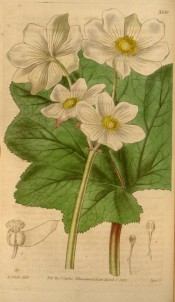Begonia octopetala L’Hér.
Frost-tender, tuberous, low-growing begonia with large, kidney shaped leaves, to 30cm across and half as long, deeply lobed and serrated, with a stout and fleshy scape to 60cm, bearing white flowers in autumn. [RHSD, Krempin].
Horticultural & Botanical History
‘Of all the begonias cultivated in the stove this is certainly the most conspicuous in its inflorescence, some of the flowers being 3 inches in diameter. It appears to have been first cultivated in the Paris gardens, from seeds sent there about the year 1778, by Mr. Joseph Dombey.’ Introduced to Britain in 1788. [Fl.Ca. p.51/1838]. It is likely that the later introduction to the Liverpool Botanic Garden by John McLean in 1835 was responsible for its wide dissemination. ‘Tubers of this truly fine species of Begonia were sent in 1835 from Lima, by John M’Lean, Esq., to the Glasgow Botanic Garden, where the large flowers, like those of an Anemone, were produced in the stove during the months of October and November in the following year.’ [BM t.3559/1837].
History at Camden Park
Probably short-lived in the gardens, listed only in the 1845 catalogue.
Notes
Published Jun 20, 2009 - 03:18 PM | Last updated Sep 06, 2011 - 04:29 PM
| Family | Begoniaceae |
|---|---|
| Category | |
| Region of origin | Ecuador, Peru |
| Synonyms |
Begonia grandiflora Kn. & West |
| Common Name | |
| Name in the Camden Park Record | Begonia octopetala
|
| Confidence level | high |


